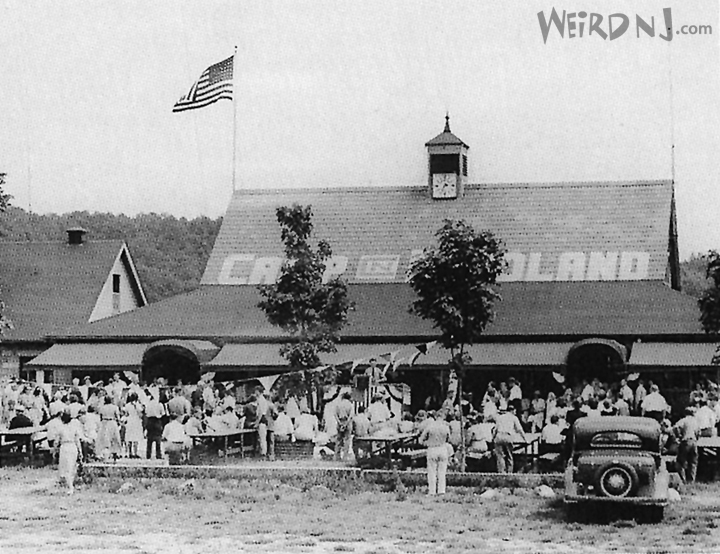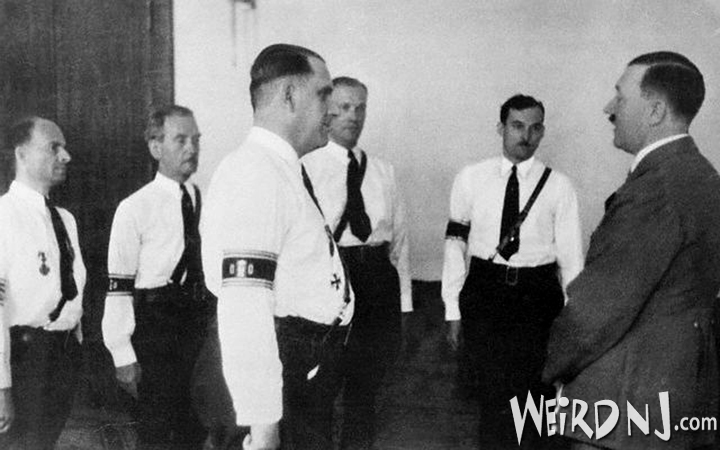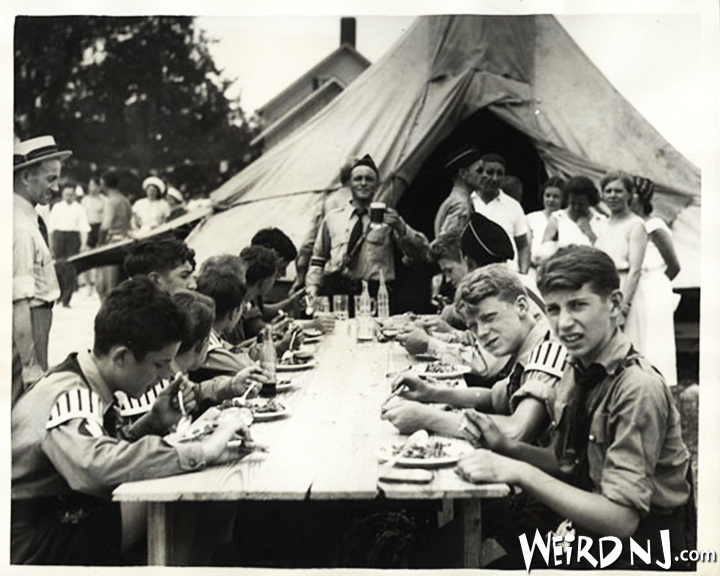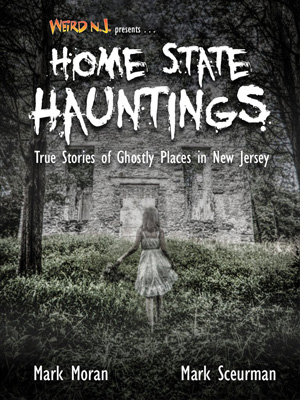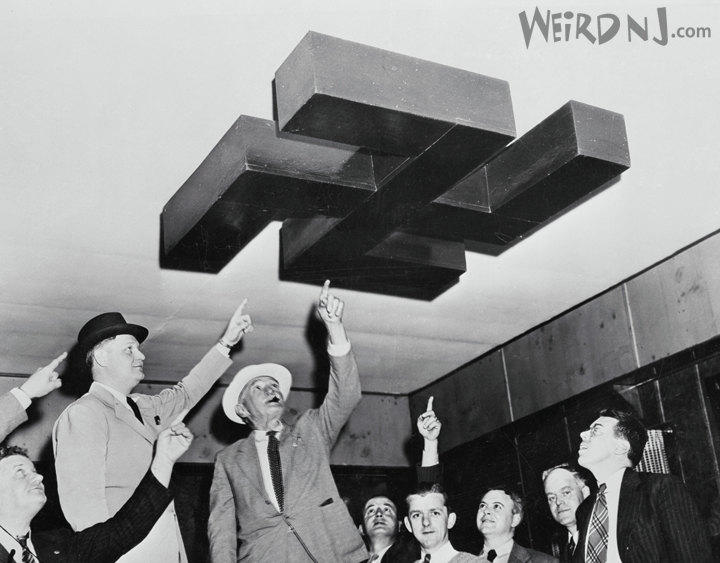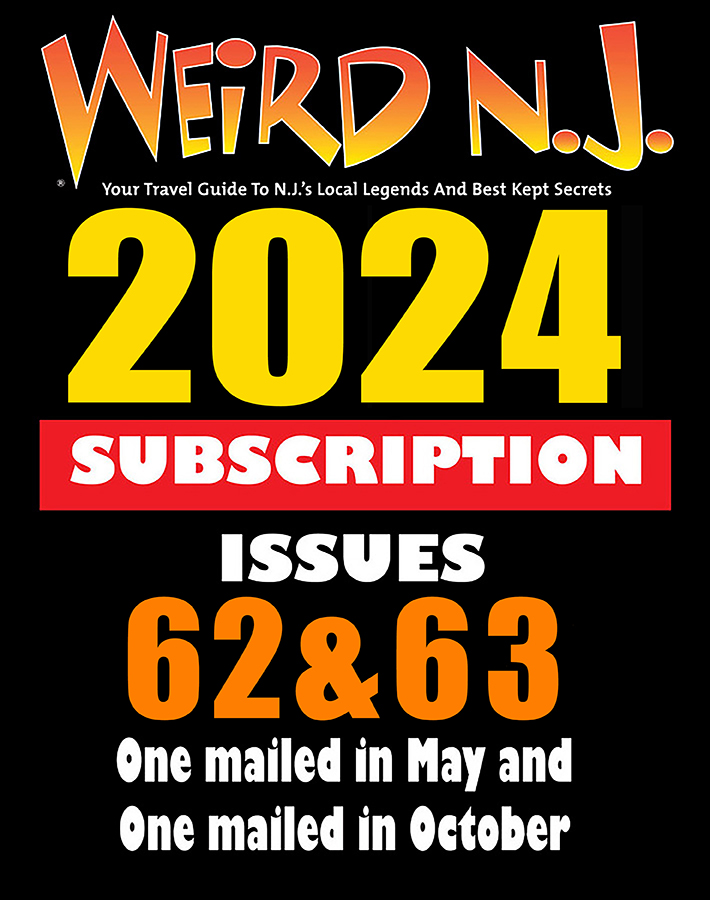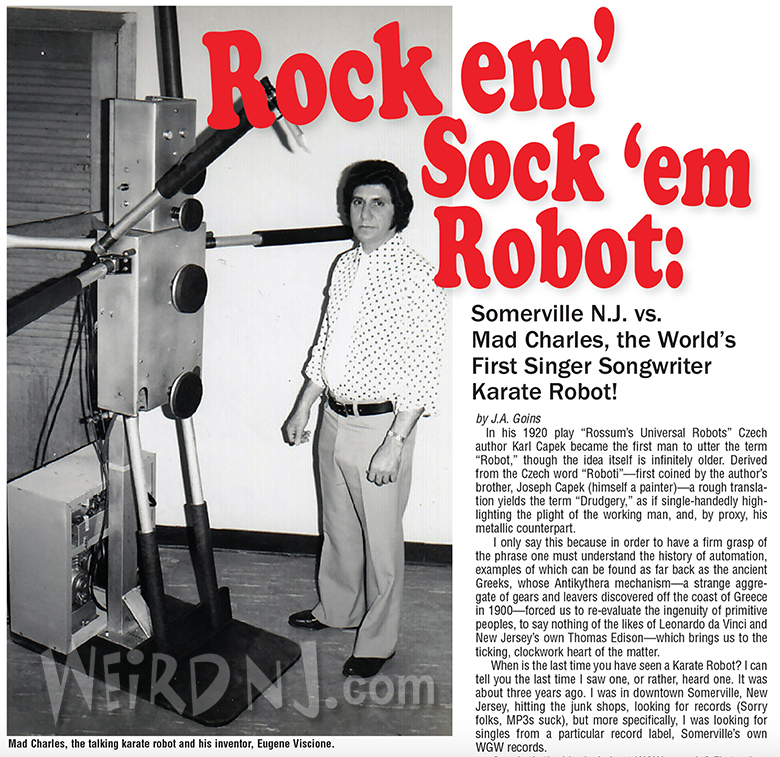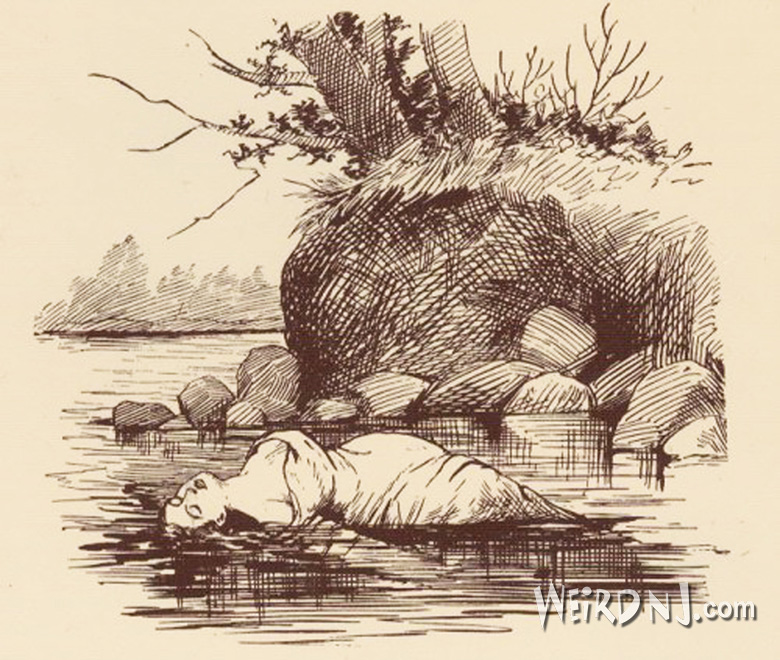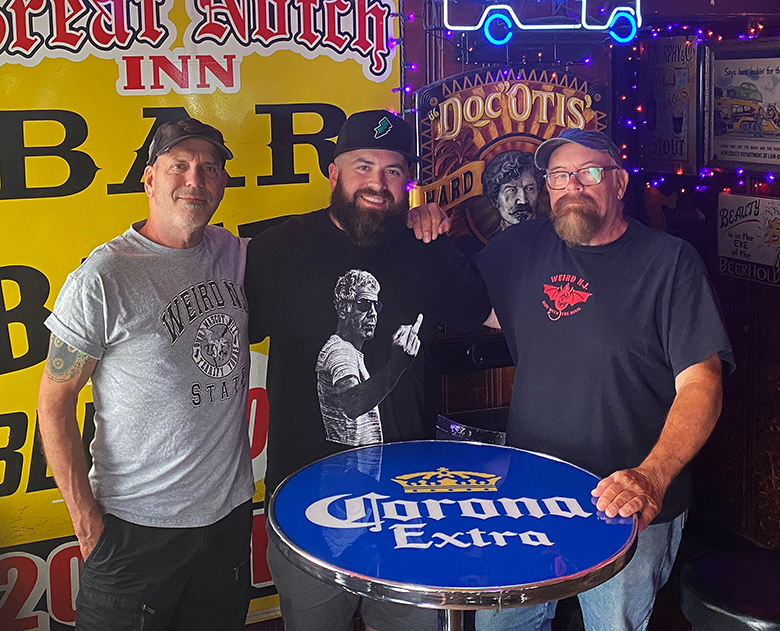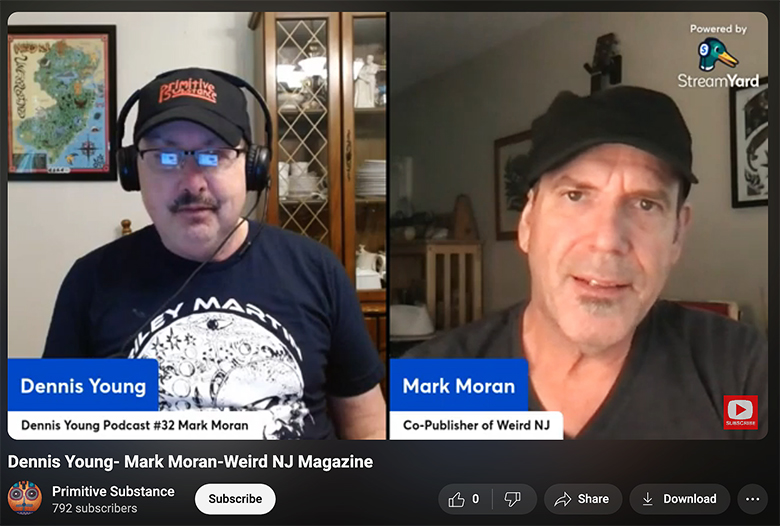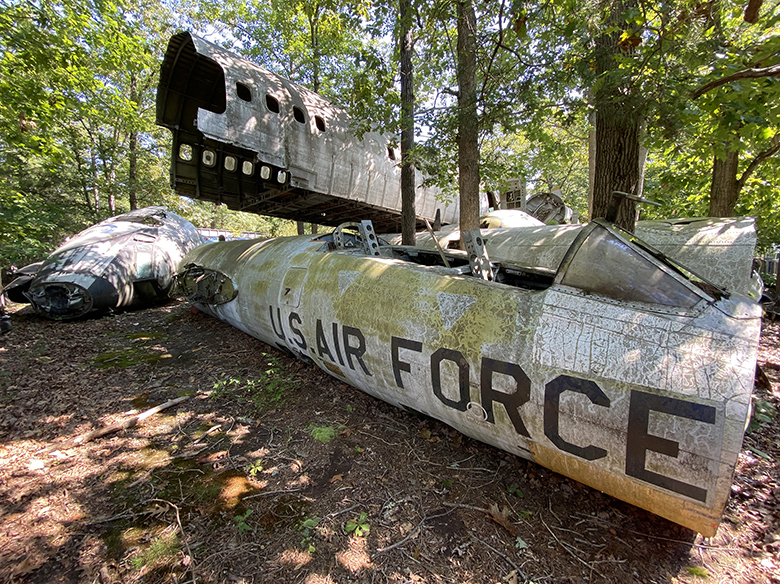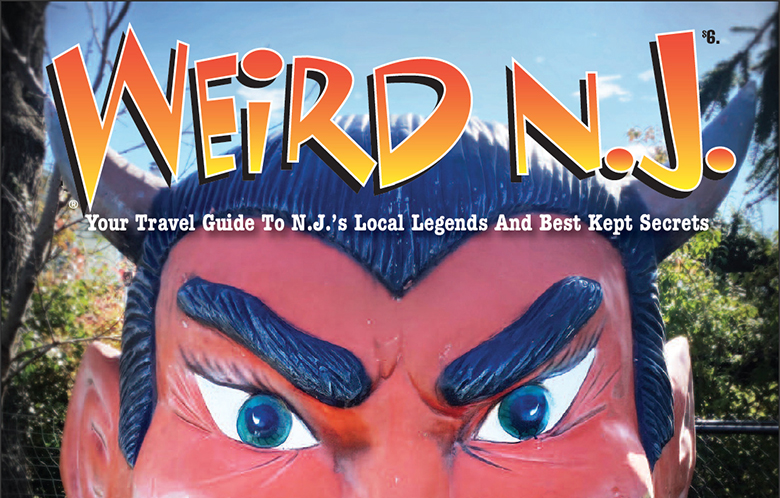Nazis and KKK Bund Together for the “American Fuhrer”
Today it’s hard to imagine that the following sentence is describing an actual rally that once took place in a rural Sussex County, NJ town: “Flames from the wooden cross, forty feet high, crackled into the night throwing lurid shadows on the participants below, some of whom were dressed in hooded white robes, others in the gray uniforms of the German-American Bund. The scene took place at Bund Camp Nordland in New Jersey on August 18, 1940, when the Klan staged a monster anti-war, pro-American mass meeting jointly with the Bund.”
Camp Nordland, Andover, NJ.
Today it’s hard to imagine that the following sentence could be describing an actual rally that once took place in a rural Sussex County town of Andover, NJ: “Flames from the wooden cross, forty feet high, crackled into the night throwing lurid shadows on the participants below, some of whom were dressed in hooded white robes, others in the gray uniforms of the German-American Bund. The scene took place at Bund Camp Nordland in New Jersey on August 18, 1940, when the Klan staged a monster anti-war, pro-American mass meeting jointly with the Bund.”
The passage was written by local north Jersey author and historian Frank Dale, and is an accurate recounting of what took place at the German-American Bund Camp Nordland in the days leading up to the U.S. entering World War II. During the years prior to WWII, America was in the grips of the worst economic depression that the nation had ever experienced. Unemployment was at a record high, and soup lines were a common sight in major cities across the country. Clashes between plant owners and labor unions often turned into bloody melees. At the same time it was becoming more evident that our nation’s participation in the conflict overseas was imminent. Unrest and frustration amongst the working classes opened the door of opportunity to a number of fringe political ideologies that might never have seemed like viable alternatives before.
There was a resurgence in the Communist Party in the U.S., and even the Ku Klux Klan was enjoying an era of record recruitment. Overseas in Germany, Adolph Hitler had taken a bankrupt post World War I nation in chaos and revitalized the economy and self-image of the populous (albeit at the expense of certain ethnic groups which were blamed for all of the country’s ills). It was a time of great uncertainty, high tensions, and mistrust. Here at home that mistrust was aimed squarely at German-Americans. In the 1930s, there were 112,000 German-born immigrants living in New Jersey. They were second in number only to Italian-Americans as the largest foreign-born ethnic population. Almost one quarter of the citizens of the United States at the time were of German descent.
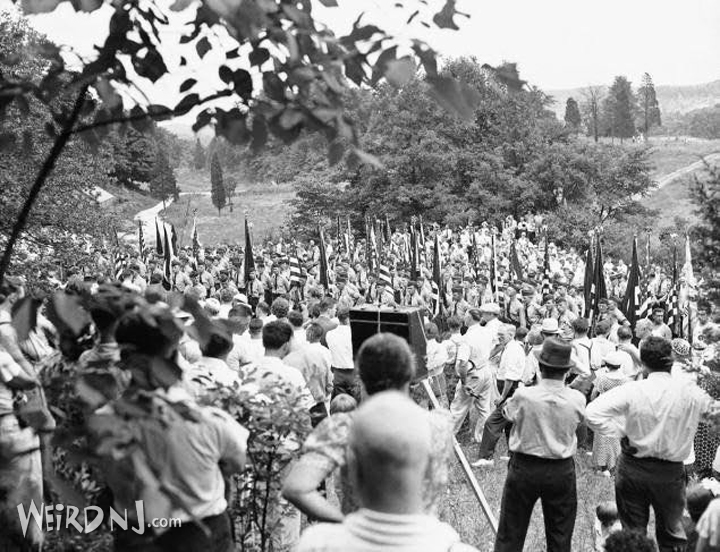
So how did these new New Jerseyans deal with the political climate here, and the influence of the Nazi Party, which was becoming all powerful back in their homeland? Generally there were three different viewpoints that most German-Americans ascribed to: Many embraced their Americanism and rejected Germany altogether; A large portion recognized Germany as their homeland, the place where their parents came from and where their cousins still lived, but did not condone the actions of the new government there; Then there was a third group––the group that proudly embraced Nazi ideals and pledged their allegiance to them. This faction would come to be known as the Bund (which means federation). It was the American equivalent of the Nazi party, and boasted over 10,000 members––and its history is intricately tied to New Jersey.
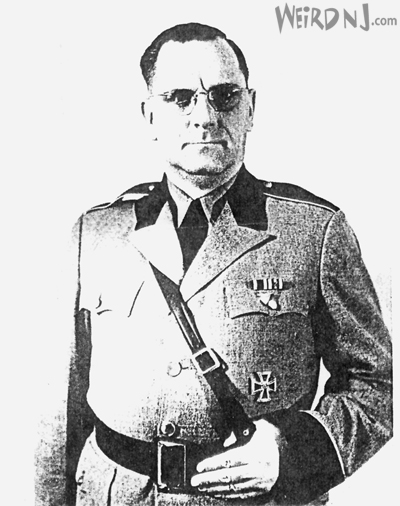
The Bund started out as a group known as “The Friends of the New Germany,” which had regional chapters scattered throughout the nation. The Bund was endorsed by the Nazi party in Germany and even given funding by them. In 1935, a Munich-born German Army veteran of WWI named Fritz Kuhn was chosen as the organization’s national leader, and the group was renamed the German-American Bund. Kuhn was hand-picked to head the Bund by Hitler himself, because he was a U.S. citizen, unlike former leaders who were German nationals. Kuhn’s first action as the new Bundesleiter was to travel to Berlin to meet with Hitler and get his blessing, and official recognition as the “American Führer.”
The Bund’s headquarters were located in the Yorkville section of Manhattan, an enclave of German-American citizens, and recently immigrated Germans nationals. The Bund had other chapters in cities across the country with high populations of German immigrants.
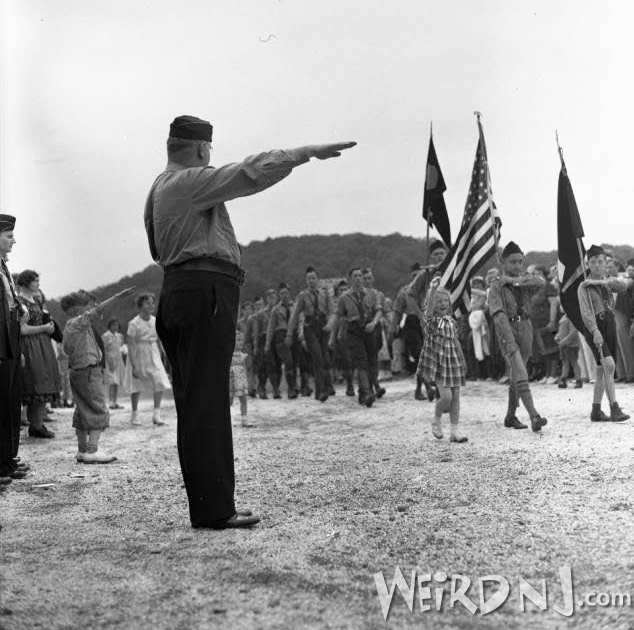 In New Jersey chapters were located in Clifton, Hackensack, Union City, Fairfield, North Bergen, Passaic, and Newark. Incredibly, the Bund promoted itself as a pro-American organization, preaching the values of isolationism and nationalism, while conveniently slipping anti-Semitic and racist rhetoric into their public message.
In New Jersey chapters were located in Clifton, Hackensack, Union City, Fairfield, North Bergen, Passaic, and Newark. Incredibly, the Bund promoted itself as a pro-American organization, preaching the values of isolationism and nationalism, while conveniently slipping anti-Semitic and racist rhetoric into their public message.
The Bund’s anti-war stance was, of course, merely an endeavor to keep the United States out of the war in Europe, so that Hitler might have his way with the entire continent, and ultimately the world. The Bund promoted solidarity among its members by running camps, which were used as recreational facilities and training grounds, and were located all across the nation. These camps provided weekend retreats where German-Americans could drink beer, sing songs of the Fatherland, converse openly in their native tongue, and take comfort in the knowledge of their own racial superiority.
28 Jul 1937: “American Führer” Fritz Kuhn pays a social call to his idol, Adolph Hitler, in Berlin, Germany.
Three such camps existed in New Jersey, one in Bloomingdale, one in Griggstown, and most importantly, Camp Nordland in Andover. Camp Nordland opened on July 18, 1937, and initially local residents were pretty happy about it. Its opening festivities drew 10,000 German-Americans to Andover, a town with a population of 479 people at the 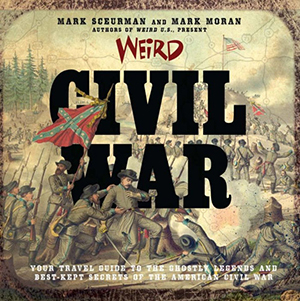 time. These out-of-towners patronized local businesses (though they were encouraged to only buy from Aryan owned shops). The Andover Fire Department even raffled off a car at the opening ceremonies of the camp, selling over 1,500 tickets. This flood of money led most locals to tolerate the Bund––despite their wearing of swastikas and military uniforms, the large portrait of Hitler they displayed on the main wall of their recreation hall, and the parade they held with their guests, a group of Italian-Americans dressed as Mussolini’s Blackshirts, who marched around giving the fascist salute. In a short time, this tolerance would disappear.
time. These out-of-towners patronized local businesses (though they were encouraged to only buy from Aryan owned shops). The Andover Fire Department even raffled off a car at the opening ceremonies of the camp, selling over 1,500 tickets. This flood of money led most locals to tolerate the Bund––despite their wearing of swastikas and military uniforms, the large portrait of Hitler they displayed on the main wall of their recreation hall, and the parade they held with their guests, a group of Italian-Americans dressed as Mussolini’s Blackshirts, who marched around giving the fascist salute. In a short time, this tolerance would disappear.
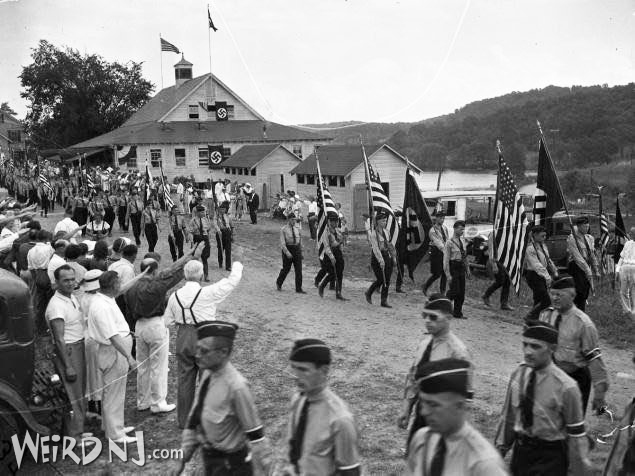
Before long, local newspapers and town leaders began to condemn the Bund, and spread the word that the organization was promoting violence, denouncing Jews, and verbally bashing Franklin Roosevelt’s New Deal (which they referred to as “Franklin Rosenfeld’s Jew Deal”). State newspapers began picking up on the controversy, and the state government became interested in Bundist activity. They warned the organizers of Camp Nordland that they were violating a New Jersey law that forbade the promotion of race hatred and race hostility. Undaunted by the warnings, the Bund simply toned down their public visibility, and began delivering speeches at the camp in German rather than English. The camp still hosted large gatherings, including weekend getaways for children. To the outside observer, these events may have looked like nothing more than Boy Scout jamborees or church retreats, but in actuality they were much more sinister. In the woods of Andover, 10 to14-year-old boys and girls were marching around in Nazi garb, and being formed into ranks very reminiscent of the infamous Hitler Youth. “Our camp,” Bundesleiter Kuhn proclaimed “is designed principally to be a place which breathes the spirit of the New Germany…(where young people) shall be strengthened and confirmed in National Socialism so that they will be conscious of the role which has been assigned to them as the future carriers of German racial ideals to America.”
Hitler Youth at Camp Nordland 1939: The ‘Heil Hitler!’ toast to the Führer is an important part of the meal for Jugendschaft members at Camp Nordland.
Those ideals included calls for a “white man’s Christian country,” a “Gentile-ruled United States,” and a barring of Jews from “all positions of importance in the government, national defense and educational institutions.” By 1939, American public opinion had begun to turn against the Bund. Hitler’s armies had invaded Austria and Czechoslovakia, and before the year’s end, they would march into Poland. As news of
Nazi atrocities in these vanquished countries began to filter back to the U.S., any illusions of the Bund as a benign social fraternity evaporated. Not only did Jewish groups often protest at Camp Nordland, but New Jerseyans of German descent were also in the ranks of the demonstrators, carrying signs that read “Hitler ist nicht Deutschland” (Hitler is not Germany).
In one incident protests turned so violent that the Bund called local police, begging them to stop a Jewish Veterans group from throwing rocks at them. Besides their ideologies, certain Bund activities at Camp Nordland garnered bad publicity. One Bund leader was arrested in Brooklyn for sexually molesting two high school girls at Camp Nordland. A 17-year-old girl testified that she and her friends were served liquor at the camp’s bar, leading the town of Andover to deny renewal of the camp’s liquor license. Fritz Kuhn himself was under investigation for personally misappropriating funds from the organization, and the IRS was keeping a watchful eye on the group as a whole. Spurred on by his embezzlement allegations, several DWI convictions, and scandalized by a few extra-marital flings with underage girls, Kuhn stepped down from his post, and Gerhard Kunze of Union City became the new Bundesfuhrer. Around this time, Sussex County Sheriff Denton Quick began a personal crusade against the Bund. He would attend meetings at Nordland, where he recorded the license plates of every car in the parking lot. His work interested both the FBI and the IRS. In the end, a congressional committee became involved in the investigation of Camp Nordland.
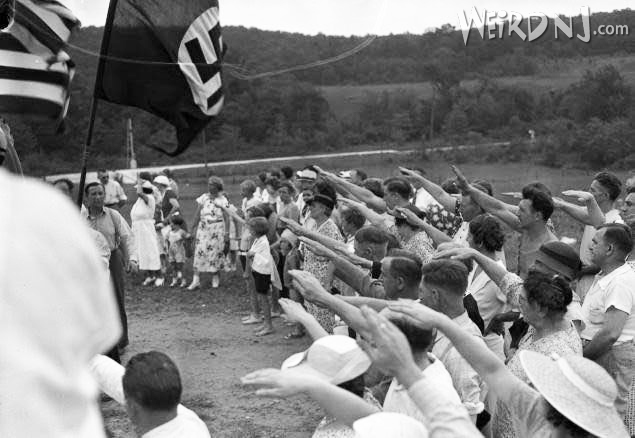
Eventually, nine leaders of the camp were indicted. They were convicted, but after several appeals, the convictions were overturned. The former leader of the Bund, Fritz Kuhn, was not so lucky. During his compatriots’ trial, Kuhn was convicted of grand larceny for embezzling $14,000 from the Bund, and sent to Sing Sing prison in upstate New York. By 1940 things were looking grim for the Bund, and they desperately wanted to rebuild their all-American German image of years past. Their solution (definitely not the smartest) was to invite the Ku Klux Klan (who claimed some 60,000 New Jerseyans as members) to Camp Nordland for a joint rally.
The gathering was described in a book published in 1943 by an author who went undercover to infiltrate the Bund and observe their activities. He wrote: “Flames from the wooden cross, forty feet high, crackled into the night throwing lurid shadows on the participants below, some of whom were dressed in hooded white robes, others in the gray uniforms of the German-American Bund. The scene took place at Bund Camp Nordland in New Jersey on August 18, 1940, when the Klan staged a monster anti-war, pro-American mass meeting jointly with the Bund.
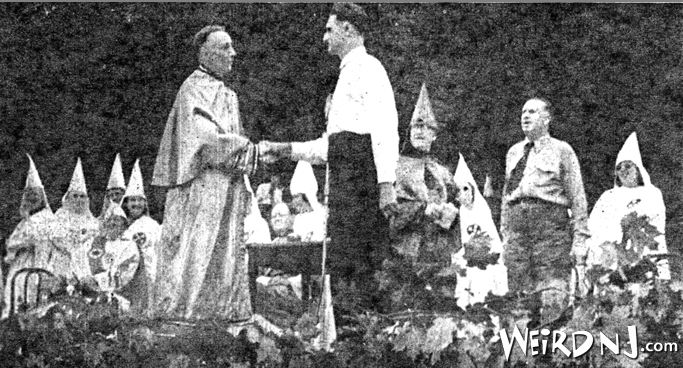 “…Klansmen berated ‘Romanism,’ called Catholics ‘dumb ring-kissers’ … Whatever power or money the Jews had, has been confiscated. But a world-wide militant Catholic organization directed from Rome remains a sinister threat to our Americanism.
“…Klansmen berated ‘Romanism,’ called Catholics ‘dumb ring-kissers’ … Whatever power or money the Jews had, has been confiscated. But a world-wide militant Catholic organization directed from Rome remains a sinister threat to our Americanism.

“By mid-afternoon 3,500 Klansmen and Bundists had assembled at Camp Nordland…August Klapprott, the vice-president of the Bund, speaking with a thick German accent, shouted: ‘When Arthur Bell, your Grand Giant, asked us about using Camp Nordland for this patriotic meeting, we decided to let them have it because of the common bond between us. The principles of the Bund and the principles of the Klan are the same.'”
The Grand Giant extended his hand to the Bundesfuhrer, and symbolized the merging of international fascism with the nationalist, or American brand of fascism. The merry racists spent the rest of the day burning crosses and ranting about minorities, until incensed local residents attacked the camp, causing the frightened leaders of the rally to once again call the local police. That same year terrorist attacks began occurring in the area and were attributed to the Bund. One of these incidents was when the Hercules Powder Company of Kenvil, in Morris County, exploded. Forty eight people died in the explosion, which occurred only ten miles from Camp Nordland.
Sheriff Quick raided the camp but found no evidence of Bund involvement. Quick declared that the explosion was sabotage, and summoned federal troops, but the cause of the explosion was never uncovered. In his 1999 self-published pamphlet, Warren County Chronicles: The Undercover Boys, author Frank T. Dale describes the final days of Camp Nordland: “The year 1941 was a bad one for the German-American Bund. In the spring, a bill came before the New Jersey legislature revoking the charter of the German-American Bund Auxiliary, the owner of Camp Nordland. It wasn’t passed in time to legally stop the big May Day opening at the camp, but Sheriff Quick acted anyway. On April 30, he and 10 deputized American Legionaries struck. Quick dispersed the Bundists he found, confiscated some material he thought the FBI would like to see, permitted the press to photograph Hitler’s portrait and the huge swastikas affixed to the roofs, and then he padlocked the place as a public nuisance. Camp Nordland would never open again.
Sheriffs Investigating Swastika on Ceiling 1941: Deputies assist Sheriff Denton J. Quick of Sussex County in raid on German American Bund Camp Nordland at Andover. They are shown examining a swastika decoration on the ceiling of one of the assembly halls at the camp.
“Things then went from bad to worse for the Bund in New Jersey. The courts consistently supported the camp’s closure. The IRS filed income tax liens against the Bund and against (Camp Nordland’s leader) Klapprott. The county increased the tax assessment against Camp Nordland while denying its owners the right to use it…In mid-summer the final betrayal occurred: the Ku Klux Klan met in Central Jersey – even the horses wore hoods for the occasion – and burned a cross to celebrate the demise of the Bund in New Jersey.” In December of 1941 the Japanese bombed Pearl Harbor, and the United States entered the war with Japan and Germany. This made all investigations of the Bund moot, as Nazis in America were now officially enemies of the state. The German-American Bund disbanded.
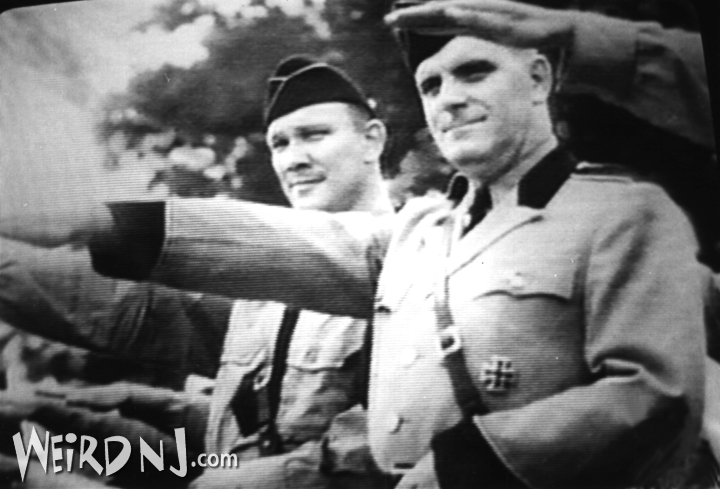 After being paroled from Sing Sing in 1943, Fritz Kuhn was sent to an enemy alien internment camp in Crystal City, Texas to sit out the rest of the war. Unrepentant, he continued his crusade within the camp, introducing the other inmates to the ways of the Nazi Party. After the war, Kuhn was deported back to Germany, where he died five years later in 1951.
After being paroled from Sing Sing in 1943, Fritz Kuhn was sent to an enemy alien internment camp in Crystal City, Texas to sit out the rest of the war. Unrepentant, he continued his crusade within the camp, introducing the other inmates to the ways of the Nazi Party. After the war, Kuhn was deported back to Germany, where he died five years later in 1951.
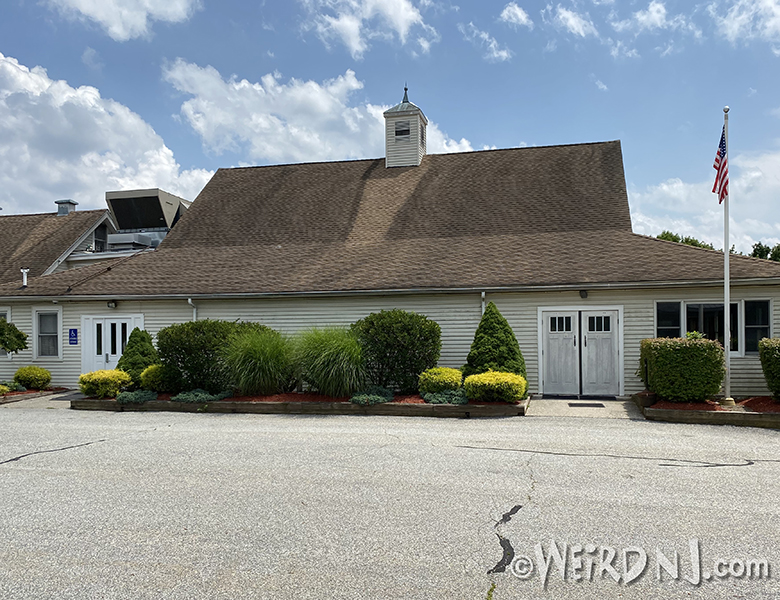
Today, the 205 acres on the banks of Lake Iliff that Camp Nordland once occupied are used as recreational fields. The buildings, which once served as guard watchtowers and the in-camp home of Fritz Kuhn, stand within Hillside Park in Andover. One would never guess that this peaceful setting, where children are now encouraged to play together, was once the ground used to instruct children how to hate one another.
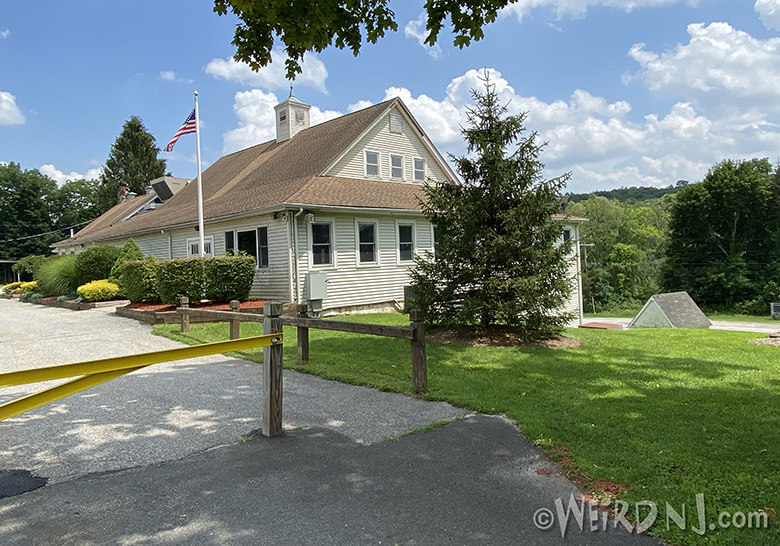
The preceding article is an excerpt from Weird NJ magazine, “Your Travel Guide to New Jersey’s Local Legends and Best Kept Secrets,” which is available on newsstands throughout the state and on the web at www.WeirdNJ.com. All contents ©Weird NJ and may not be reproduced by any means without permission.
Visit our SHOP for all of your Weird NJ needs: Magazines, Books, Posters, Shirts, Patches, Stickers, Magnets, Air Fresheners. Show the world your Jersey pride some of our Jersey-centric goodies!
Now you can have all of your favorite Weird NJ icons on all kinds of cool new Weird Wear, Men’s Wear, Women’s Wear, Kids, Tee Shirts, Sweatshirts, Long Sleeve Tees, Hoodies, Tanks Tops, Tie Dyes, Hats, Mugs & Backpacks! All are available in all sizes and a variety of colors. Visit WEIRD NJ MERCH CENTRAL. Represent New Jersey!
![]()

